Welcome Freshers
Jürgen Vollmer
Our tour on the 10th of October addressed international students joining the universities in Leipzig. It was an opportunity to come to know each other, and it informed them about the contributions of the Leipzig research institutions to Arts and Sciences. We also discussed challenges of international study programs, of living as an expat in a foreign country, and exchanged ideas about cultural and recreational activities.
Physics Building
We started the tour with a welcome to the participants, and a dive into the contributions of Leipzig researchers to quantum, solid-state and nuclear physics. Work performed in Leipzig was awarded with several Nobel prices, and numerous students and visitors of the institute became Nobel laureates later on in their careers (cf. this list of Leipzig Nobel laureates).
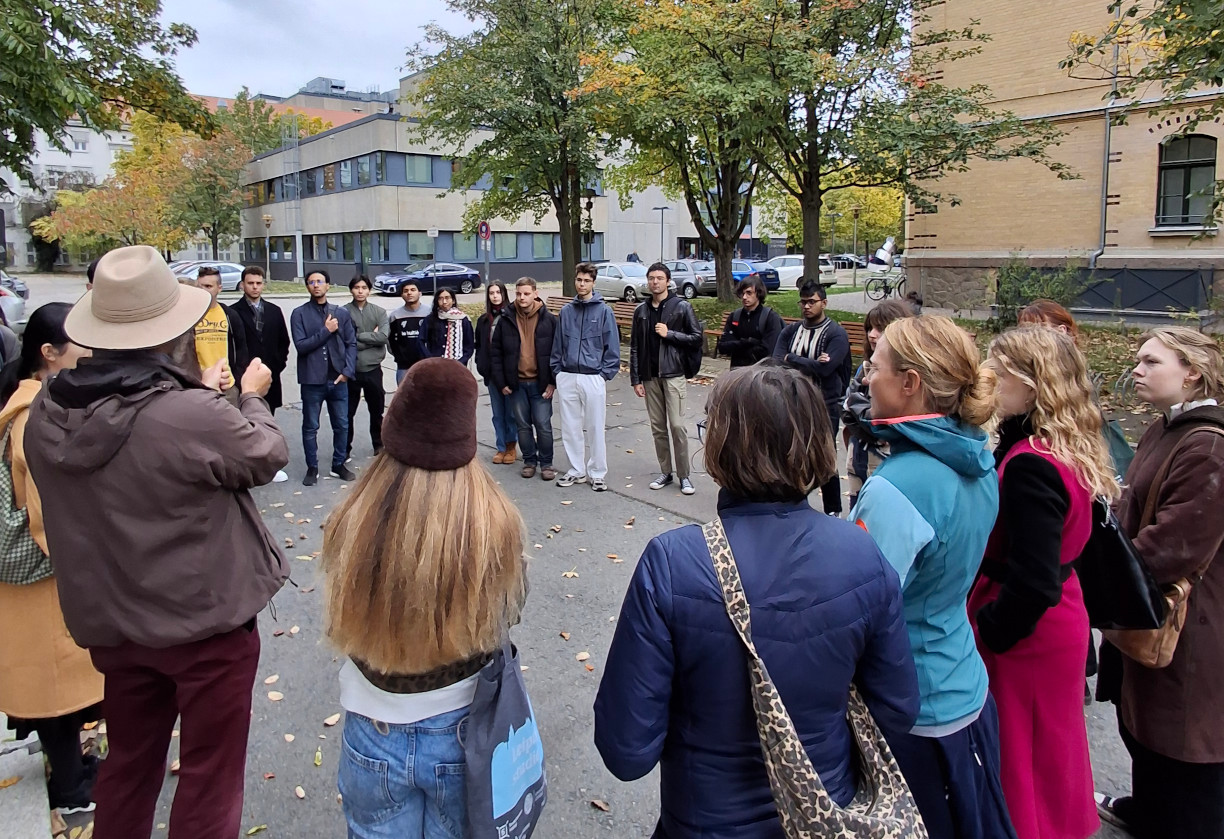
Welcome in front of the Physics building. Photo: Team WissensSpuren.
Women in STEM
Early on Leipzig was a center of womens rights, emancipation, and education (cf. the recollection of our tour commemorating 50 years “International Women’s Year”). Since the 19th century women enrolled in the the university, and since the 1880s women earned scientific and medical degrees. For instance Alice Hamilton was a visiting student in Leipzig in 1895, she took up her first professorship in 1896, and in 1919 she became the first female professor in Harvard. In contrast, in Germany the female graduates commonly married, and at best they collaborated with their husbands and supported their careers. Noticeable examples in Leipzig are Friedrich Hund’s wife Ingeborg Seynsche, and and Robert Döpel’s wife Klara Mannß. The former received a doctorate in Mathematics in Göttingen, and the latter was one of the first female lawyers in Germany.
The Academic Quarter
On the medical research campus in the Liebigstraße we revisited Leipzig’s traditions of school and higher education.
The St. Thomas School (founded in 1212) is one of the oldest schools in Europe,
the St. Nicholas School (inaugurated in 1512) is one of the oldest secular schools in Europe, and Leipzig University (founded 1409) is among the top 50 of old universities with continuous operation.
Moreover, from the reformation till WWII Leipzig University had been among the richest universities in the world.
A multitude of new education movements and new research directions were pioneered in Leipzig due to patronal support of the Electors of Saxonia and by the local bourgeoisie.

History of the university in the Liebigstraße. Photo: Team WissensSpuren.
Hidden gems: Allotment gardens and the first Jewish cemetery
On our way we walked past the allotments of the KGV Johannistal 1832 e.V.. Allotment gardens were set up to improve the food situation of industrial workers in Germany, and those in the Johannistal gardens are the second-oldest in Germany. Moreover, nowadays the area also contains the remains of the oldest Jewish cemetery in Leipzig.
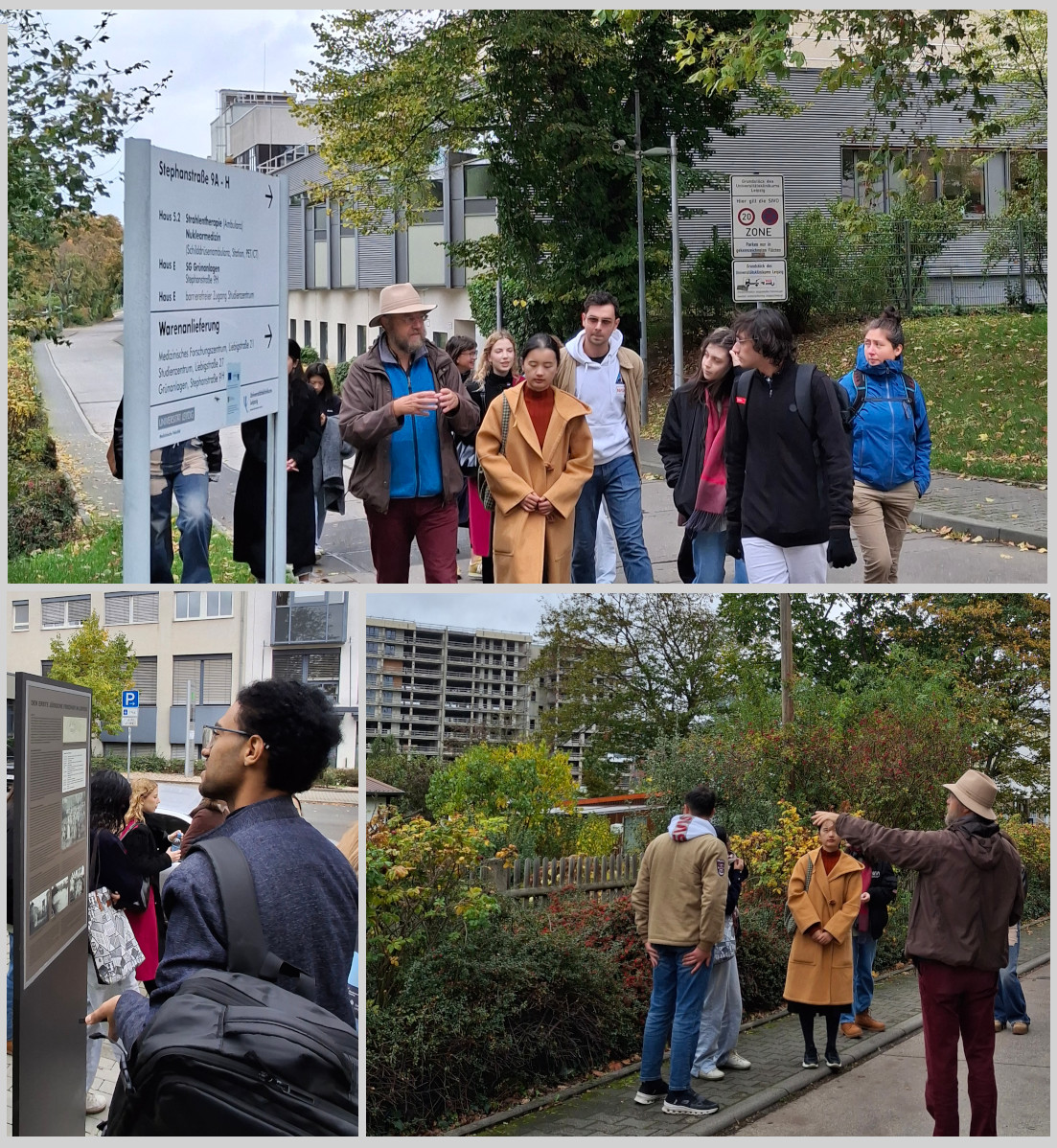
Top: Discussions on the way. Bottom right: Allotment gardens. Bottom Left: Stela commemorating the old Jewish cemetery. Photos: Team WissensSpuren.
MPI CBS
The Max-Planck-Institute for Human Cognitive and Brain Sciences (MPI CBS) was formed in 2003 as a merger of institutes for Neuropsychological and Psychological Research, and subsequently it took a leading role in the fostering multidisciplinary research at the interface of these fields.
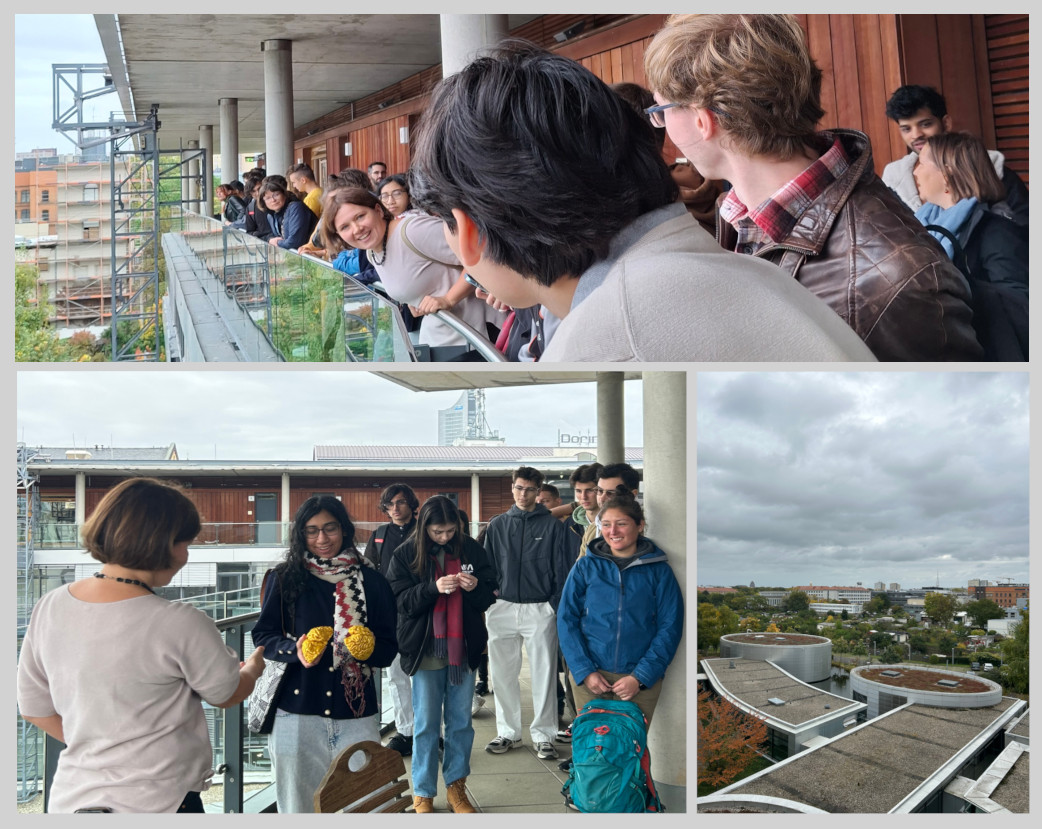
Top: Birds eye view from the top of the institute. Bottom right: Experimental halls with NMR facilities and a view over the city of Leipzig. Bottom left: Insights from MRI Biophysics research. Photos: Team WissensSpuren.
Evgeniya Kirilina, the head of the MRI Biophysics group, told us about the mission of the institute and the aims of the research in her group. It was amazing to see first hand how physics, biochemistry, medicine and carefully developed psychological tests interlock in the research performed at the MPI.
Dubnow Institute
The Leibniz Institute for Jewish History and Culture – Simon Dubnow (Dubnow Institute) conducts multidisciplinary and historically comprehensive research on Jewish life in Central and Eastern Europe. In a variety of aspects its research touches the life-realities of international students:
- Is it worth to give up ones home country for better educational or job perspectives?
- How does one build social networks and keep social contact with persons that are living far away?
- How does one collect information about the living conditions and political circumstances in the home countries of fellow students?
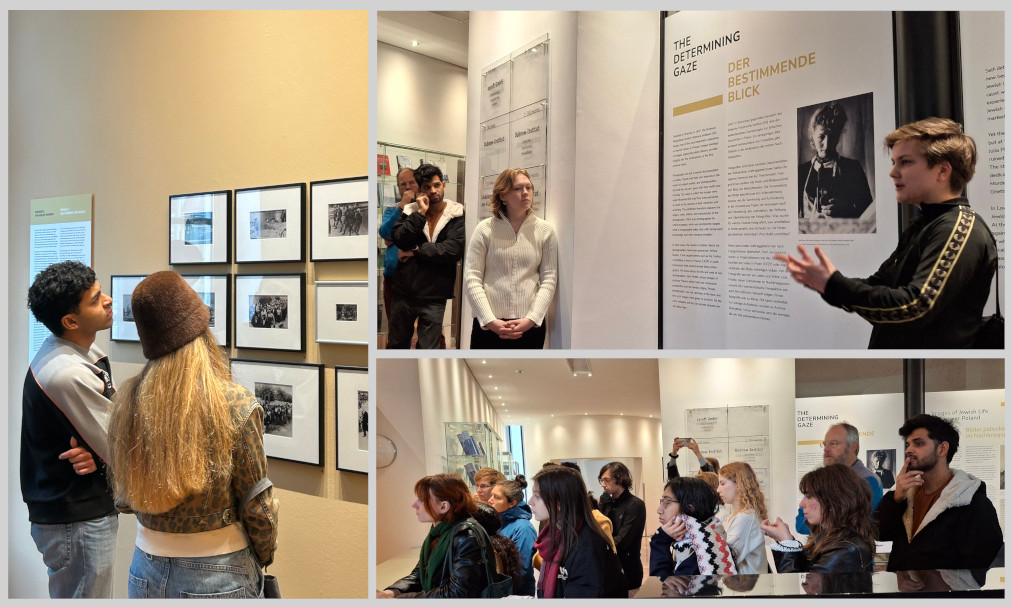
Visiting the Dubnow Institute, and its exhibition «The Determining Gaze». Photos: Team WissensSpuren.
Julia Salomo, an academic assistant in the Knowledge Transfer unit of the Dubnow Institute, provided us with a brief introduction to the research focus of the institute, and she was our guide through the the exhibition The Determining Gaze. The exhibition addresses how the questions from above emerged in the lifes of Jews in post WWII Poland. It documents efforts to stay and (re-)build communities, decisions to leave, and highlights that documentations of reality are never neutral. This holds true for historic records that strive to minimize biases — and it is even more relevant in news coverage.
Grassi Museum for Ethnology
Sabine Wohlfarth, the head of the Educational Program of the Grassi Museum for Ethnology, welcomed us in the Grassi — a museum quarter in the city center of Leipzig that is a place of encounters hosting three museums of international fame. She informed us about the REINVENTING GRASSI.SKD project. This project strives to turn the museum from a showroom of European perspectives on foreign cultures to a network museum in which different voices are heard and different places are connected with each other.
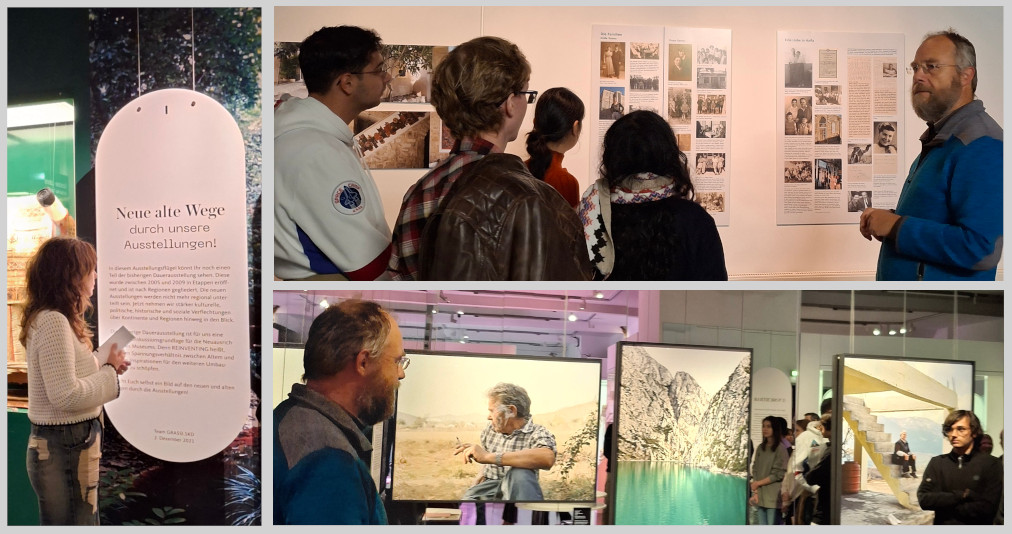
(Left) Look into the old permanent exhibition of the Grassi Museum for Ethnology. (Top right) Exhibition about Emile and Haya Touma in the Rapid Response Room. (Bottom right) Section (In)visible of the REINVENTING GRASSI.SDK showrooms. Photos: Team WissensSpuren.
In the museum we expanded the scope of our discussion about working and living in expat communities by visiting the exhibition «Handreichungen» (Handouts) in the Rapid Response Room. It is dedicated to the shared life of the Palestinian-Israeli couple Emile and Haya Touma. Their love and lifelong work as an artist and a politician stands for holding on to a vision of peaceful coexistence. Subsequently, we visited the section (In)visible of the REINVENTING GRASSI.SDK showrooms. It offers a wide range of opportunities to question and break down perceived boundaries of (traditional) role models and gender images.
Forum of Contemporary History
The final stage of our tour was a visit to the Forum of Contemporary History Leipzig. There were many participants from Easter Europe who shared family memories about the division of Europe in the cold war, the fall of the Berlin wall and the changes it initiated in Eastern Europe, and the present fights of the civil society to preserve civil rights.

(Top left) The big three at the Potsdam conference. (Top right) Tanks at Checkpoint Charlie. (Bottom right) Underground art. (Bottom center) Voting for Gorbachev on the May Day demonstration in 1989. (Bottom left) Oppression of demonstrations in Poland in the mid 1980s. Photos: Team WissensSpuren.
Acknowledgements
We sincerely thank the MPI CBS, the Dubnow Institute, the Grassi Museum for Ethnology, and the Forum of Contemporary History for welcoming us on this tour — and we are immensely grateful to Evgeniya Kirilina and Julia Salomo for generously sharing their vast knowledge and insights.